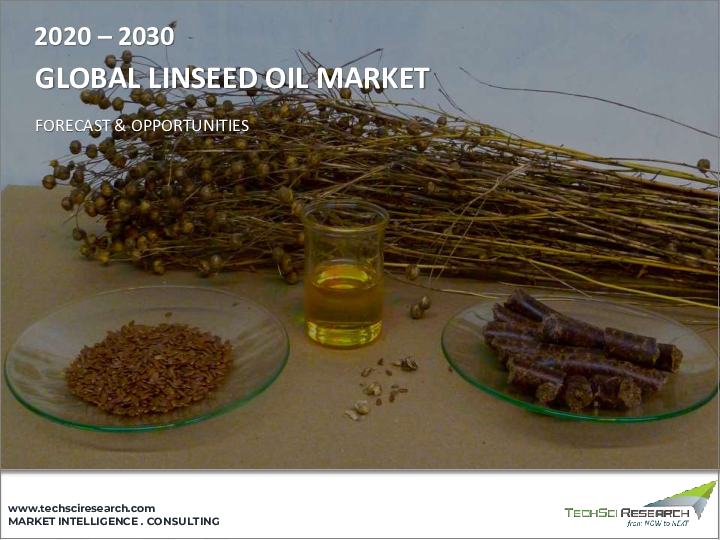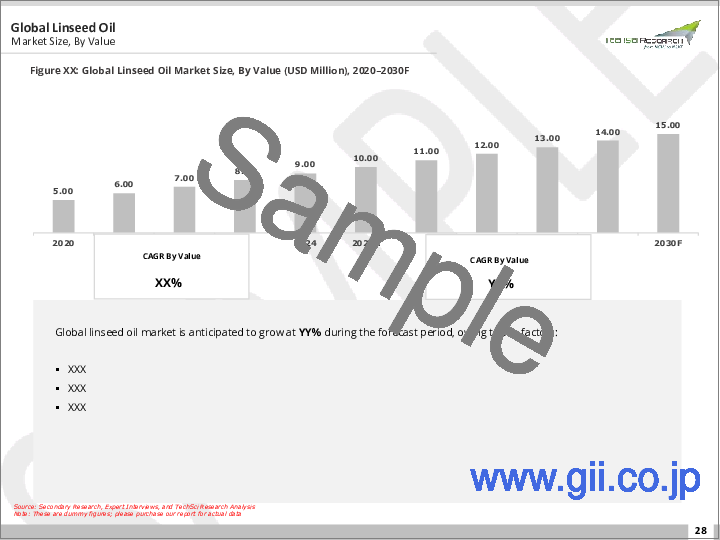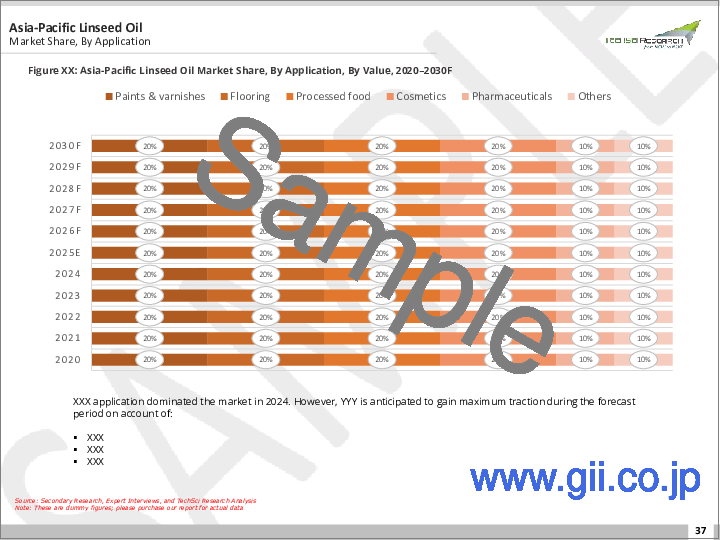|
|
市場調査レポート
商品コード
1692244
亜麻仁油市場- 世界の産業規模、シェア、動向、機会、予測、種類別、用途別、地域別、競合別、2020-2030年予測Linseed Oil Market - Global Industry Size, Share, Trends, Opportunity, and Forecast, Segmented By Type, By Application, By Region and Competition, 2020-2030F |
||||||
カスタマイズ可能
|
|||||||
| 亜麻仁油市場- 世界の産業規模、シェア、動向、機会、予測、種類別、用途別、地域別、競合別、2020-2030年予測 |
|
出版日: 2025年03月24日
発行: TechSci Research
ページ情報: 英文 184 Pages
納期: 2~3営業日
|
全表示
- 概要
- 目次
亜麻仁油の世界市場規模は2024年に14億3,000万米ドルで、予測期間中のCAGRは4.63%で2030年には15億8,000万米ドルに達すると予測されています。
世界の亜麻仁油市場は、食用油業界の中でもダイナミックで急速に発展している分野です。亜麻仁由来の亜麻仁油は、その多くの健康上の利点と多様な用途により、近年大きな人気を博しています。この市場概要では、その成長を促進する主な要因、現在の動向、将来の見通しについて掘り下げています。亜麻仁油世界市場の主な促進要因の一つは、亜麻仁油の消費に伴う健康効果に関する消費者の意識の高まりです。オメガ3脂肪酸、抗酸化物質、必須栄養素を豊富に含む亜麻仁油は、心臓の健康を促進し、炎症を抑え、全身の健康をサポートするスーパーフードと考えられています。健康志向の消費者がより健康的な食生活を求める中、栄養補助食品や代替食用油としての亜麻仁油の需要が急増しています。
| 市場概要 | |
|---|---|
| 予測期間 | 2026-2030 |
| 市場規模:2024年 | 14億3,000万米ドル |
| 市場規模:2030年 | 15億8,000万米ドル |
| CAGR:2025年~2030年 | 4.63% |
| 急成長セグメント | ボイルド亜麻仁油 |
| 最大市場 | アジア太平洋 |
様々な産業における亜麻仁油の用途拡大が市場成長を後押ししています。亜麻仁油は、その自然乾燥特性により、塗料、ワニス、コーティング剤の製造に広く使用されています。さらに、保湿効果やアンチエイジング効果があるため、スキンケアやヘアケア製品にも使用されています。
世界の亜麻仁油市場は、オーガニックとコールドプレスの製品に顕著な傾向が見られます。オーガニック亜麻仁油は、無農薬で持続可能な選択肢を求める環境意識の高い消費者にアピールしています。コールドプレス加工された亜麻仁油は、加熱加工されたオイルに比べ、天然の栄養素と風味をより多く保持しており、健康志向の消費者に好まれる選択となっています。
市場促進要因
健康上の利点に対する消費者の意識の高まり
主な市場課題
亜麻仁価格の変動
主要市場動向
医薬品・化粧品用途
目次
第1章 概要
第2章 調査手法
第3章 エグゼクティブサマリー
第4章 顧客の声
第5章 世界の亜麻仁油市場展望
- 市場規模・予測
- 金額別
- 市場シェア・予測
- 種類別(生亜麻仁油、煮沸亜麻仁油、二度煮沸亜麻仁油、淡色煮沸亜麻仁油)
- 用途別(塗料・ワニス、床材、加工食品、化粧品、医薬品、その他)
- 地域別
- 企業別(2024)
- 市場マップ
第6章 北米の亜麻仁油市場展望
- 市場規模・予測
- 市場シェア・予測
- 北米:国別分析
- 米国
- カナダ
- メキシコ
第7章 欧州の亜麻仁油市場展望
- 市場規模・予測
- 市場シェア・予測
- 欧州:国別分析
- ドイツ
- 英国
- イタリア
- フランス
- スペイン
第8章 アジア太平洋地域の亜麻仁油市場展望
- 市場規模・予測
- 市場シェア・予測
- アジア太平洋地域:国別分析
- 中国
- インド
- 日本
- 韓国
- オーストラリア
第9章 南米の亜麻仁油市場展望
- 市場規模・予測
- 市場シェア・予測
- 南米:国別分析
- ブラジル
- アルゼンチン
- コロンビア
第10章 中東・アフリカの亜麻仁油市場展望
- 市場規模・予測
- 市場シェア・予測
- 中東・アフリカ:国別分析
- 南アフリカ
- サウジアラビア
- アラブ首長国連邦
第11章 市場力学
- 促進要因
- 課題
第12章 市場動向と発展
- 合併と買収
- 製品の発売
- 最近の動向
第13章 ポーターのファイブフォース分析
- 業界内の競合
- 新規参入の可能性
- サプライヤーの力
- 顧客の力
- 代替品の脅威
第14章 競合情勢
- Henry Lamotte Oils GmbH
- Gustav Heess GmbH
- Krishi Oils Limited(KOL)
- Cargill, Incorporated
- Archer Daniels Midland(ADM)Company
- Natrol LLC
- Natural Factors Inc.
- Bioriginal Food & Science Corp
- Barlean's Organic Oils, LLC
- Granovita SAU
第15章 戦略的提言
第16章 調査会社について・免責事項
Global Linseed Oil Market was valued at USD 1.43 Billion in 2024 and is expected to reach USD 1.58 Billion by 2030 with a CAGR of 4.63% during the forecast period. The global linseed oil market is a dynamic and rapidly evolving sector within the broader edible oils industry. Linseed oil, derived from flaxseeds, has gained significant popularity in recent years due to its numerous health benefits and versatile applications. This market overview delves into the key factors driving its growth, current trends, and future prospects. One of the primary drivers of the global linseed oil market is the increasing consumer awareness regarding the health benefits associated with linseed oil consumption. Rich in omega-3 fatty acids, antioxidants, and essential nutrients, linseed oil is considered a superfood that promotes heart health, reduces inflammation, and supports overall well-being. As health-conscious consumers seek healthier dietary choices, the demand for linseed oil as a nutritional supplement and cooking oil alternative has surged.
| Market Overview | |
|---|---|
| Forecast Period | 2026-2030 |
| Market Size 2024 | USD 1.43 Billion |
| Market Size 2030 | USD 1.58 Billion |
| CAGR 2025-2030 | 4.63% |
| Fastest Growing Segment | Boiled Linseed Oil |
| Largest Market | Asia-pacific |
The expanding applications of linseed oil in various industries have propelled its market growth. Linseed oil is extensively used in the production of paints, varnishes, and coatings due to its natural drying properties. Additionally, it finds application in the pharmaceutical and cosmetic sectors, where it is used in skincare and haircare products for its moisturizing and anti-aging properties.
The global linseed oil market is witnessing a notable trend towards organic and cold-pressed variants. Organic linseed oil appeals to environmentally conscious consumers seeking pesticide-free and sustainable options. Cold-pressed linseed oil retains more of its natural nutrients and flavors compared to heat-processed oils, making it a preferred choice for health-conscious individuals.
Key Market Drivers
Increasing Consumer Awareness of Health Benefits
Increasing consumer awareness of the health benefits associated with linseed oil consumption has been a pivotal driver behind the remarkable growth of the global linseed oil market. In recent years, consumers have become increasingly health-conscious, seeking out natural and nutritious dietary options. Linseed oil, derived from flaxseeds, has gained widespread recognition as a nutritional powerhouse. It is particularly esteemed for its high content of omega-3 fatty acids, including alpha-linolenic acid (ALA), which has been linked to various health benefits.
One of the key health benefits that has resonated with consumers is linseed oil's potential to promote heart health. ALA, found abundantly in linseed oil, plays a crucial role in reducing the risk of cardiovascular diseases. Studies have shown that regular consumption of omega-3 fatty acids can lower cholesterol levels, manage blood pressure, and improve overall cardiovascular well-being. As individuals become more conscious of the importance of heart health, linseed oil has gained popularity as a dietary supplement and a heart-healthy cooking oil alternative.
Moreover, linseed oil is rich in antioxidants and essential nutrients, making it a superfood that supports overall well-being. These antioxidants help combat free radicals in the body, reducing oxidative stress and potentially lowering the risk of chronic diseases. The presence of nutrients like vitamin E and various minerals further enhances its appeal to health-conscious consumers. The increasing focus on preventive healthcare and holistic well-being has further fueled the demand for linseed oil. Consumers are proactively seeking out foods and ingredients that offer health benefits beyond basic nutrition. Linseed oil fits this demand perfectly, and its versatile use in cooking, baking, and as a salad dressing allows consumers to easily incorporate it into their daily diets.
Key Market Challenges
Fluctuations in Flaxseed Prices
The global linseed oil market, derived from flaxseeds, has experienced remarkable growth driven by its health benefits and diverse applications. However, one of the significant challenges it faces is the volatility in flaxseed prices, which can hinder market stability and profitability. Flaxseeds, the primary source of linseed oil, are subject to price fluctuations influenced by various factors. These fluctuations are primarily driven by agricultural conditions, including crop yields, weather patterns, and global demand. When supply and demand dynamics shift, so do flaxseed prices, impacting the cost of linseed oil production.
One of the primary challenges stemming from fluctuating flaxseed prices is the difficulty in maintaining consistent pricing for linseed oil products. When the cost of flaxseeds rises due to factors like poor crop yields or increased demand, linseed oil manufacturers may find themselves facing higher production costs. These increased costs can then be passed on to consumers in the form of higher prices, potentially making linseed oil less competitive in the market. Furthermore, fluctuating flaxseed prices can introduce uncertainty into the linseed oil supply chain. Producers may struggle to secure a stable and affordable source of flaxseeds, making it challenging to meet demand consistently. This can lead to production delays and supply shortages, which can negatively impact customer relationships and market share.
Key Market Trends
Pharmaceutical and Cosmetic Uses
Pharmaceutical and cosmetic uses have played a significant role in boosting the global linseed oil market. Linseed oil, derived from flaxseeds, has garnered considerable attention in these industries due to its remarkable properties that contribute to skincare, haircare, and pharmaceutical applications.
In the pharmaceutical sector, linseed oil's unique composition, particularly its high content of omega-3 fatty acids and antioxidants, has made it a valuable ingredient in various healthcare products. Omega-3 fatty acids, including alpha-linolenic acid (ALA), are essential for human health and have been associated with numerous benefits, including anti-inflammatory effects and cardiovascular support. Linseed oil supplements are commonly used to provide these essential fatty acids to individuals who may not consume them in adequate amounts through their regular diets. This has led to increased demand for linseed oil as a dietary supplement. In 2021, Cargill entered into a strategic partnership with Frontline International to implement Kitchen Controllers, a solution aimed at enhancing operational efficiency and management capabilities for foodservice operators.
Key Market Players
- Henry Lamotte Oils GmbH
- Gustav Heess GmbH
- Krishi Oils Limited (KOL)
- Cargill, Incorporated
- Archer Daniels Midland (ADM) Company
- Natrol LLC
- Natural Factors Inc.
- Bioriginal Food & Science Corp
- Barlean's Organic Oils, LLC
- Granovita SA
Report Scope:
In this report, the Global Linseed Oil Market has been segmented into the following categories, in addition to the industry trends which have also been detailed below:
Linseed Oil Market, By Type:
- Raw Linseed Oil
- Boiled Linseed Oil
- Double boiled Linseed Oil
- Pale Boiled Linseed Oil
Linseed Oil Market, By Application:
- Paints & varnishes
- Flooring
- Processed food
- Cosmetics
- Pharmaceuticals
- Others
Global Linseed Oil Market, By Region:
- North America
- United States
- Canada
- Mexico
- Europe
- France
- United Kingdom
- Italy
- Germany
- Spain
- Asia-Pacific
- China
- India
- Japan
- Australia
- South Korea
- South America
- Brazil
- Argentina
- Colombia
- Middle East & Africa
- South Africa
- Saudi Arabia
- UAE
Competitive Landscape
Company Profiles: Detailed analysis of the major companies present in the Global Linseed Oil Market.
Available Customizations:
Global Linseed Oil Market report with the given market data, TechSci Research offers customizations according to a company's specific needs. The following customization options are available for the report:
Company Information
- Detailed analysis and profiling of additional market players (up to five).
Table of Contents
1. Product Overview
- 1.1. Market Definition
- 1.2. Scope of the Market
- 1.2.1. Markets Covered
- 1.2.2. Years Considered for Study
- 1.2.3. Key Market Segmentations
2. Research Methodology
- 2.1. Objective of the Study
- 2.2. Baseline Methodology
- 2.3. Key Industry Partners
- 2.4. Major Association and Secondary Sources
- 2.5. Forecasting Methodology
- 2.6. Data Triangulation & Validations
- 2.7. Assumptions and Limitations
3. Executive Summary
- 3.1. Overview of the Market
- 3.2. Overview of Key Market Segmentations
- 3.3. Overview of Key Market Players
- 3.4. Overview of Key Regions/Countries
- 3.5. Overview of Market Drivers, Challenges, Trends
4. Voice of Customer
5. Global Linseed Oil Market Outlook
- 5.1. Market Size & Forecast
- 5.1.1. By Value
- 5.2. Market Share & Forecast
- 5.2.1. By Type (Raw Linseed Oil, Boiled Linseed Oil, Double boiled Linseed Oil, Pale Boiled Linseed Oil)
- 5.2.2. By Application (Paints & varnishes, Flooring, Processed food, Cosmetics, Pharmaceuticals, Others)
- 5.2.3. By Region
- 5.2.4. By Company (2024)
- 5.3. Market Map
6. North America Linseed Oil Market Outlook
- 6.1. Market Size & Forecast
- 6.1.1. By Value
- 6.2. Market Share & Forecast
- 6.2.1. By Type
- 6.2.2. By Application
- 6.2.3. By Country
- 6.3. North America: Country Analysis
- 6.3.1. United States Linseed Oil Market Outlook
- 6.3.1.1. Market Size & Forecast
- 6.3.1.1.1. By Value
- 6.3.1.2. Market Share & Forecast
- 6.3.1.2.1. By Type
- 6.3.1.2.2. By Application
- 6.3.1.1. Market Size & Forecast
- 6.3.2. Canada Linseed Oil Market Outlook
- 6.3.2.1. Market Size & Forecast
- 6.3.2.1.1. By Value
- 6.3.2.2. Market Share & Forecast
- 6.3.2.2.1. By Type
- 6.3.2.2.2. By Application
- 6.3.2.1. Market Size & Forecast
- 6.3.3. Mexico Linseed Oil Market Outlook
- 6.3.3.1. Market Size & Forecast
- 6.3.3.1.1. By Value
- 6.3.3.2. Market Share & Forecast
- 6.3.3.2.1. By Type
- 6.3.3.2.2. By Application
- 6.3.3.1. Market Size & Forecast
- 6.3.1. United States Linseed Oil Market Outlook
7. Europe Linseed Oil Market Outlook
- 7.1. Market Size & Forecast
- 7.1.1. By Value
- 7.2. Market Share & Forecast
- 7.2.1. By Type
- 7.2.2. By Application
- 7.2.3. By Country
- 7.3. Europe: Country Analysis
- 7.3.1. Germany Linseed Oil Market Outlook
- 7.3.1.1. Market Size & Forecast
- 7.3.1.1.1. By Value
- 7.3.1.2. Market Share & Forecast
- 7.3.1.2.1. By Type
- 7.3.1.2.2. By Application
- 7.3.1.1. Market Size & Forecast
- 7.3.2. United Kingdom Linseed Oil Market Outlook
- 7.3.2.1. Market Size & Forecast
- 7.3.2.1.1. By Value
- 7.3.2.2. Market Share & Forecast
- 7.3.2.2.1. By Type
- 7.3.2.2.2. By Application
- 7.3.2.1. Market Size & Forecast
- 7.3.3. Italy Linseed Oil Market Outlook
- 7.3.3.1. Market Size & Forecast
- 7.3.3.1.1. By Value
- 7.3.3.2. Market Share & Forecast
- 7.3.3.2.1. By Type
- 7.3.3.2.2. By Application
- 7.3.3.1. Market Size & Forecast
- 7.3.4. France Linseed Oil Market Outlook
- 7.3.4.1. Market Size & Forecast
- 7.3.4.1.1. By Value
- 7.3.4.2. Market Share & Forecast
- 7.3.4.2.1. By Type
- 7.3.4.2.2. By Application
- 7.3.4.1. Market Size & Forecast
- 7.3.5. Spain Linseed Oil Market Outlook
- 7.3.5.1. Market Size & Forecast
- 7.3.5.1.1. By Value
- 7.3.5.2. Market Share & Forecast
- 7.3.5.2.1. By Type
- 7.3.5.2.2. By Application
- 7.3.5.1. Market Size & Forecast
- 7.3.1. Germany Linseed Oil Market Outlook
8. Asia-Pacific Linseed Oil Market Outlook
- 8.1. Market Size & Forecast
- 8.1.1. By Value
- 8.2. Market Share & Forecast
- 8.2.1. By Type
- 8.2.2. By Application
- 8.2.3. By Country
- 8.3. Asia-Pacific: Country Analysis
- 8.3.1. China Linseed Oil Market Outlook
- 8.3.1.1. Market Size & Forecast
- 8.3.1.1.1. By Value
- 8.3.1.2. Market Share & Forecast
- 8.3.1.2.1. By Type
- 8.3.1.2.2. By Application
- 8.3.1.1. Market Size & Forecast
- 8.3.2. India Linseed Oil Market Outlook
- 8.3.2.1. Market Size & Forecast
- 8.3.2.1.1. By Value
- 8.3.2.2. Market Share & Forecast
- 8.3.2.2.1. By Type
- 8.3.2.2.2. By Application
- 8.3.2.1. Market Size & Forecast
- 8.3.3. Japan Linseed Oil Market Outlook
- 8.3.3.1. Market Size & Forecast
- 8.3.3.1.1. By Value
- 8.3.3.2. Market Share & Forecast
- 8.3.3.2.1. By Type
- 8.3.3.2.2. By Application
- 8.3.3.1. Market Size & Forecast
- 8.3.4. South Korea Linseed Oil Market Outlook
- 8.3.4.1. Market Size & Forecast
- 8.3.4.1.1. By Value
- 8.3.4.2. Market Share & Forecast
- 8.3.4.2.1. By Type
- 8.3.4.2.2. By Application
- 8.3.4.1. Market Size & Forecast
- 8.3.5. Australia Linseed Oil Market Outlook
- 8.3.5.1. Market Size & Forecast
- 8.3.5.1.1. By Value
- 8.3.5.2. Market Share & Forecast
- 8.3.5.2.1. By Type
- 8.3.5.2.2. By Application
- 8.3.5.1. Market Size & Forecast
- 8.3.1. China Linseed Oil Market Outlook
9. South America Linseed Oil Market Outlook
- 9.1. Market Size & Forecast
- 9.1.1. By Value
- 9.2. Market Share & Forecast
- 9.2.1. By Type
- 9.2.2. By Application
- 9.2.3. By Country
- 9.3. South America: Country Analysis
- 9.3.1. Brazil Linseed Oil Market Outlook
- 9.3.1.1. Market Size & Forecast
- 9.3.1.1.1. By Value
- 9.3.1.2. Market Share & Forecast
- 9.3.1.2.1. By Type
- 9.3.1.2.2. By Application
- 9.3.1.1. Market Size & Forecast
- 9.3.2. Argentina Linseed Oil Market Outlook
- 9.3.2.1. Market Size & Forecast
- 9.3.2.1.1. By Value
- 9.3.2.2. Market Share & Forecast
- 9.3.2.2.1. By Type
- 9.3.2.2.2. By Application
- 9.3.2.1. Market Size & Forecast
- 9.3.3. Colombia Linseed Oil Market Outlook
- 9.3.3.1. Market Size & Forecast
- 9.3.3.1.1. By Value
- 9.3.3.2. Market Share & Forecast
- 9.3.3.2.1. By Type
- 9.3.3.2.2. By Application
- 9.3.3.1. Market Size & Forecast
- 9.3.1. Brazil Linseed Oil Market Outlook
10. Middle East and Africa Linseed Oil Market Outlook
- 10.1. Market Size & Forecast
- 10.1.1. By Value
- 10.2. Market Share & Forecast
- 10.2.1. By Type
- 10.2.2. By Application
- 10.2.3. By Country
- 10.3. MEA: Country Analysis
- 10.3.1. South Africa Linseed Oil Market Outlook
- 10.3.1.1. Market Size & Forecast
- 10.3.1.1.1. By Value
- 10.3.1.2. Market Share & Forecast
- 10.3.1.2.1. By Type
- 10.3.1.2.2. By Application
- 10.3.1.1. Market Size & Forecast
- 10.3.2. Saudi Arabia Linseed Oil Market Outlook
- 10.3.2.1. Market Size & Forecast
- 10.3.2.1.1. By Value
- 10.3.2.2. Market Share & Forecast
- 10.3.2.2.1. By Type
- 10.3.2.2.2. By Application
- 10.3.2.1. Market Size & Forecast
- 10.3.3. UAE Linseed Oil Market Outlook
- 10.3.3.1. Market Size & Forecast
- 10.3.3.1.1. By Value
- 10.3.3.2. Market Share & Forecast
- 10.3.3.2.1. By Type
- 10.3.3.2.2. By Application
- 10.3.3.1. Market Size & Forecast
- 10.3.1. South Africa Linseed Oil Market Outlook
11. Market Dynamics
- 11.1. Drivers
- 11.2. Challenges
12. Market Trends & Developments
- 12.1. Merger & Acquisition (If Any)
- 12.2. Product Launches (If Any)
- 12.3. Recent Developments
13. Porter's Five Forces Analysis
- 13.1. Competition in the Industry
- 13.2. Potential of New Entrants
- 13.3. Power of Suppliers
- 13.4. Power of Customers
- 13.5. Threat of Substitute Products
14. Competitive Landscape
- 14.1. Henry Lamotte Oils GmbH
- 14.1.1. Business Overview
- 14.1.2. Company Snapshot
- 14.1.3. Products & Services
- 14.1.4. Financials (As Reported)
- 14.1.5. Recent Developments
- 14.1.6. Key Personnel Details
- 14.1.7. SWOT Analysis
- 14.2. Gustav Heess GmbH
- 14.3. Krishi Oils Limited (KOL)
- 14.4. Cargill, Incorporated
- 14.5. Archer Daniels Midland (ADM) Company
- 14.6. Natrol LLC
- 14.7. Natural Factors Inc.
- 14.8. Bioriginal Food & Science Corp
- 14.9. Barlean's Organic Oils, LLC
- 14.10. Granovita SAU





